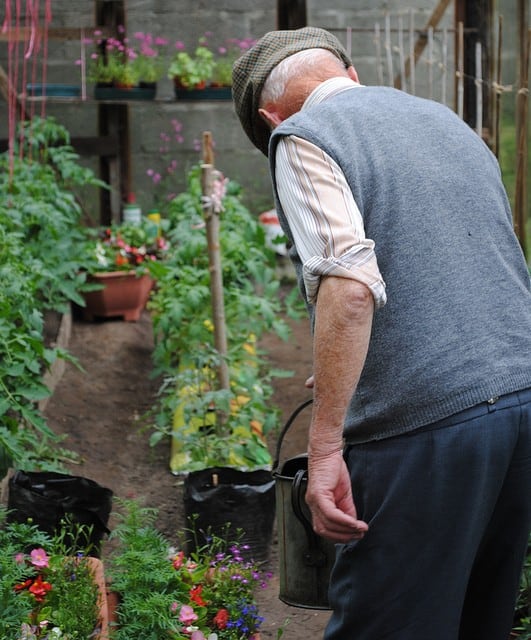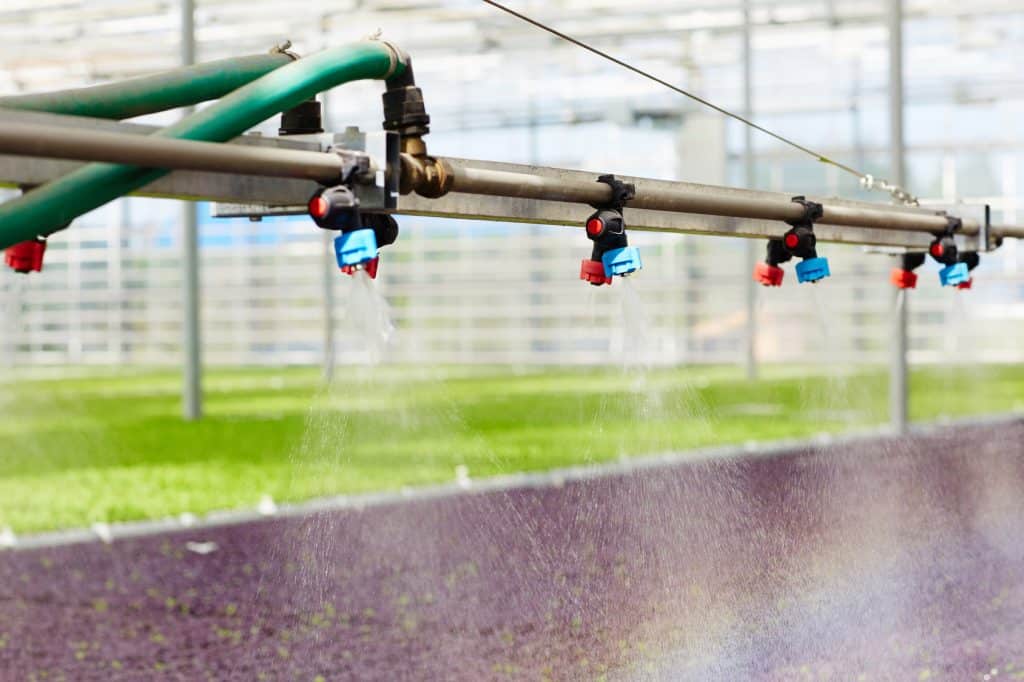Efficient greenhouse watering system are mandatory for commercial and large greenhouses. A well-developed greenhouse watering system not only rehydrates plants, it also eliminates excess cost of employing labor and hours to watering manually. In this article, we will look at some of the best greenhouse watering systems used by farmers these days. But before that, let’s go through some of the basics of good watering:
Best Greenhouse Watering Hacks
Water thoroughly each time.
Ensure that the roots are wet and that the water reaches the bottom of the pot.
Water at the base of the plant, not on the leaves or the flowers.
Excess water on the leaves can result in the growth of mold and fungus.
Rehydrate the plant before it dries out.
The best time to water plants is during the early morning when your plants have the time to dry out.
Use good quality soil which has sufficient drainage and aeration.
This can work wonders for your plant by preventing water logging at the roots.
The type of soil also matters.
Sandy soils need more frequent watering than clay soil.
Adding compost to your soil helps it to retain moisture.
Test your tap water’s salinity, hardness and alkalinity.
You might have to treat it before using it on plants.
Components of a good greenhouse watering system
Greenhouse watering systems come in several types and serve several purposes.
They are custom made to reduce water wastage with their positioning and dispensing features.
Two main greenhouse watering systems are the misting coolant mechanisms and evaporative cooling systems.
Another greenhouse watering system is drip watering.
Even hydroponics are used these days to provide climate control for plants that are not well suited for outdoor environments.
A greenhouse watering system is also called “a greenhouse irrigation system.”
Research has shown that the proper use of a greenhouse irrigation system can boost your plants and vegetables growth by as much as 70% or more.
A good greenhouse irrigation system, when installed properly, will provide you many years of watering with very little repair and maintenance.
Now let’s discuss some of the main types of greenhouse watering systems:

Misting coolant greenhouse watering system
A misting coolant system consists of PVC piping with nozzle heads of varying refinement arranged high up in the greenhouse.
The nozzles release a fine mist, which cools the hot air in the top area, thereby lowering the temperature of the entire greenhouse.
If you are looking to avoid disturbing new seedlings and the surrounding dirt, your best option is a fine grade of misting.
The mist is produced within eighteen inches of the plants you are trying to water.
Misters are best for tropical crops.
One side effect of a misting system is that your plant’s foliage will become dew laden.
For some plants, this is a bonus.
However, not all plants benefit from a misting greenhouse watering system, and for a greenhouse containing large amounts of these plants, an evaporative cooling system may be more preferable.
This system is also not very water efficient; for every ounce of water your plant absorbs, another ounce either evaporates into the air or rolls off the leaves.
Evaporative cooling greenhouse watering system
In an evaporative cooling system, water is evaporated in an enclosed space, and only the cooled air is allowed to escape into the greenhouse at large.
It operates just like an air conditioning system, only with water as the only coolant.
If you have water sensitive plants such as orchids then this system is definitely one to look into.
To know more about growing orchids in greenhouses, refer to our article here.
This type of watering system facilitates climate control.
Drip feed greenhouse watering system
If either water conservation or avoiding leaf mold is a concern for you, you may want to consider a drip feed system.
These systems feed water directly to the base of plants via plastic tubing at a set rate.
The water reached to each individual plant can be controlled with an automatic sensor.
Drip or trickle greenhouse irrigation systems work best for most vegetables and plants.
They are the most common type of watering system used these days.
They are also extremely water efficient and prevent the wetting of leaves and stems.
Sprinkler System
A sprinkler greenhouse watering system enables a gardener to water a large space at once.
Not just is this system an effective use of water, it also enables a gardener to control which parts are watered and when.
These systems can be installed inside a structure or high tunnel.
They can be used in gardens, fields and yards.
Greenhouse Aquatics
Greenhouse structures allow for good control over the growing environment of its crops.
Greenhouse aquatics take advantage of this greater environment to grow plants in very harsh weather conditions.
They create bodies of flowing or still water within the walls of the greenhouse to constantly maintain moisture levels.
Common greenhouse aquatic structures include large ponds for growing water plants, indoor water gardens, living aquariums with decorative additions like fish and other aquatic plants.
Even fountains can add to the moisture in the greenhouse while making the experience more enjoyable and tranquil.
When creating ponds inside greenhouses, you can make borders easily by lining the water body with any size or type of rocks.
You will also need to create a foundation to hold the water about a foot deep from the surface.
The water inside will need to be kept warm.
If the greenhouse structure is well insulated, the stones covering the pond at night could be enough to sustain the water warm, depending on the outside temperatures.
To maintain aquatic plants, be mindful of weeds that quickly grow to take over the pond.
They can overpower the whole surface of the area, blocking the solar energy from reaching the aquatic plants.
Weeds ought to be removed quickly and buried or composted.
Hydroponics
Hydroponics refer to a system of growing plants in a water-based, nutrient-rich rooting medium.
These systems do not have lots of heavy soil for the plants, hence the roots do not have to work themselves much to reach for nutrients.
Because of this, plants focus their energies on growing upwards rather than downwards, giving better yield and fruit.
They also use less water and soil, hence reducing wastage and overall pollution.
It also prevents the growth of mold, pests and soil degradation.
However, these systems of growing plants are for experienced hands and need a constant supply of water at all times.
They are expensive to install also.
Supplies needed for setting up a greenhouse watering system
All of the above systems require a few basic greenhouse watering supplies if you intent to assemble them at home.
You can purchase them at any hardware store.
Set up your own DIY greenhouse watering system
You will almost invariably use PVC piping to get the water from its source near your plants or into the evaporator cooler.
Then, you will either need misting nozzles to get the water airborne, or a drip line hosing to run to the individual plants.
PVC piping requires bonding tape for a water-tight seal at the joints.
Drip hosing comes with T connectors and staking to install it in the dirt.
Regardless of what type of system you use, a good greenhouse watering supply system will save you hours of labor once installed.
Automatic greenhouse watering systems
Having a greenhouse watering system that is automatic gives you the advantage of saving time and labor costs.
For this, you will need to plan out your watering system well.
You need to figure out what your vegetables and plants need in terms of moisture and water levels.
Some plants and vegetables will need more water, while others not as much.
Cut flowers prefer drip watering while vegetables can benefit from wide-reaching sprinklers.
Automatic greenhouse watering systems work in different ways.
Some by filling up a reservoir with water and dispensing it in several time intervals; others having portable timers to spray plants with different densities of water.
Making your greenhouse watering system truly efficient
Did you know that in the US alone, 38% of freshwater consumption is used solely for irrigation.
Across the world, the number is as high as 80%.
This means that there is a huge strain on water available in the water table for other purposes.
Wasteful irrigation practices can impact local water supplies in a big way.
And you can do your part to save water by implementing a few simple steps such as:
- Periodically checking for leaks and faults in piping.
- Using rain water harvesting and collecting storm water from your gutters and roof.
- Using drip watering instead of conventional methods of irrigation.
- Collecting irrigation run-offs, filtering and recirculating it within the greenhouse watering system.
- Controling the amount of solar radiation and shade within your greenhouse. This will directly impact the amount of water that will evaporate away. More about the best shade systems for greenhouses here.
Watering Orchids
Of all the flowers known, the orchid is one of the most beautiful.
A lot of people have found pleasure in growing orchids in their homes and yards.
However, not everyone knows how to water these flowers properly.
Watering orchids correctly is essential to maintain their blooming period.
Orchid growers often make the mistake of believing that as orchids are most commonly found in tropical rain forests, they will need lots of water.
But in reality, most orchids ought to be watered only once in every 5-10 days.
With too much watering, the plant can die quite easily.
In humid climates, they should be watered less often.
The frequency of watering can slightly vary depending on the weather, potting material and pot size.
Larger orchid pots with more absorptive pot material need less watering than smaller absorptive pots.
Your pot and the orchid’s roots should dry out completely before watering.
You can tell if the roots are dry and need water by simply sticking your finger about one inch into the potting.
If the soil falls off from your finger easily, it needs watering.
Moreover, the film that covers the direction of your orchid will be dry and white colored to indicate the need for water.
You should always water orchids in the morning so that they can dry off excess moisture during the day.
Best Retractable Garden Hose Reels
Greenhouse Watering Systems
A greenhouse watering system comprises of many elements which aid in plant growth, maintain moisture and in turn, help balance climate within the greenhouse.
It is synonymous with an irrigation system and comes in various types.
According to the need and type of plant, you can install overhead misting systems, evaporative coolants, hydroponics or drip systems to maximize water supply in the greenhouse.
Each one has its advantages and disadvantages, with the drip watering system being most cost-efficient.
A good greenhouse watering system for sensitive plants like orchids is essential when growing them commercially.
How to Reduce Irrigation Water Usage
It must also be noted that having excess water on the leaves and body of plants can result in growth of fungus and mold and a proper irrigation system must counter this.
There are many ways to save money on watering systems such as by reducing run-off, harvesting rain water and checking for leaks occasionally and performing periodic maintenance.
Efficient irrigation systems filter and recirculate run-offs back into the water table, hence reducing the strain on the environment.
Related Articles:
- Best Greenhouse Watering System | Greenhouse Irrigation
- Is It Illegal to Collect Rainwate
- Creeping Charlie – How to Get Rid Of or Manage

